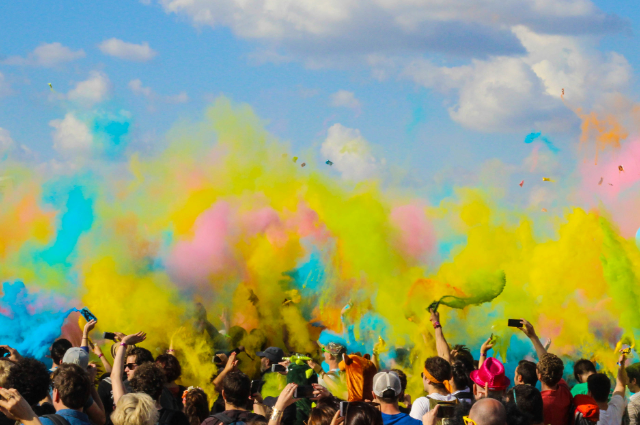
Photo by Maxime Bhm on Unsplash
Introduction
Holi, the festival of colors, transcends beyond mere celebration into a cultural extravaganza that unites India in a kaleidoscope of vibrancy. In 2024, as the nation gears up to commemorate this joyous occasion, the spectrum of traditions, customs, and rituals that define Holi is more diverse than ever.
Unraveling the Tapestry of Traditions
Holi, rooted in mythology, paints a vivid picture of India’s rich heritage and cultural tapestry. The festival signifies the triumph of good over evil, as depicted in the legend of Holika and Prahlad. This narrative varies across regions, each adding its unique flair to the festivities. In Mathura and Vrindavan, the land of Lord Krishna’s birth, Holi takes on a spiritual fervor with week-long celebrations at temples and ashrams. The Ras Lila performance, reenacting Krishna’s playful antics with the gopis, mesmerizes spectators from around the world, embodying the essence of divine love and devotion.
Echoes of History: Royal Splendor and Folklore
The royal courts of Rajasthan echo with the grandeur of Holi celebrations, where maharajas once indulged in elaborate processions and extravagant feasts. Even today, the regal charm of Jaipur’s City Palace transports visitors to a bygone era, where tradition meets opulence. Meanwhile, in the heart of Bengal, Holi intertwines with the springtime harvest festival of Dol Purnima. The state bursts into a riot of colors as Bengalis smear each other with abir, singing and dancing to the rhythm of folk songs. This fusion of agrarian customs and cultural revelry showcases the resilience and adaptability of Indian traditions.
Unity in Diversity: Pan-Indian Celebrations
While regional nuances define Holi, its essence remains universal – a celebration of unity, joy, and renewal. Across India, people from diverse backgrounds come together to partake in the festivities, breaking barriers of caste, creed, and social hierarchy. In Delhi’s bustling streets, the air is thick with laughter and excitement as communities unite for holika dahan and rangwali Holi. Similarly, in Mumbai, the spirit of Holi transcends neighborhoods, with locals and tourists alike joining in the revelry at iconic landmarks like Juhu Beach and Marine Drive.
Innovation Amidst Tradition: Modern Twists to Timeless Customs
In recent years, Holi has witnessed a modern makeover, blending age-old rituals with contemporary trends. Urban millennials embrace eco-friendly colors and organic dyes, conscious of environmental sustainability. Social media platforms become virtual forums for exchanging greetings and sharing festive moments, connecting individuals across geographical boundaries. Additionally, themed Holi parties and music festivals cater to the younger demographic, amplifying the festive spirit with DJ sets and live performances.
Preserving Cultural Heritage: Challenges and Opportunities
Despite its enduring popularity, Holi faces challenges in preserving its cultural heritage amidst rapid urbanization and globalization. Traditional artisans struggle to compete with mass-produced merchandise flooding the market, endangering age-old crafts like pichkaris and thandai. Moreover, concerns over water scarcity and chemical pollution underscore the need for sustainable practices to safeguard the environment. Initiatives promoting cultural education and heritage tourism play a pivotal role in raising awareness and fostering appreciation for India’s rich tapestry of festivals.
Conclusion: A Mosaic of Colors and Cultures
As India gears up for Holi in 2024, the festival continues to evolve, embracing change while staying true to its roots. From the sacred precincts of ancient temples to the bustling streets of metropolitan cities, Holi encapsulates the essence of India’s cultural mosaic – diverse, dynamic, and endlessly vibrant. As the nation comes together to revel in a riot of colors, Holi serves as a poignant reminder of the enduring spirit of unity and camaraderie that defines the Indian ethos.
